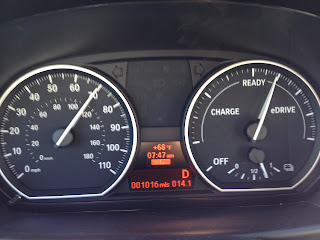Driving a pure EV takes some getting used to. Its not just that the car functions differently, it's the behavior and movement of the car that we (the motoring public) have come to anticipate, yet no longer holds true in an EV. For example, if I hit the accelerator to speed up, my years of driving ICE'd vehicles tell me that I should anticipate a slight pause as the transmission downshifts, and then an increase of horse power as the engine roars from around 2,000 RPM to 4,000 RPM. It is a process we have all felt so many times before.
None of that happens in the Active E. Instead, the car instantly accelerates without pause and without a power curve. That means if I am not prepared to change my anticipations (so that I expect a very fast acceleration), I just might find my E resting comfortable on the bumper of the car in front of me.
In the Active E, even the cruise control is not as anticipated. I have used cruise control many times before in a gas-powered car, and the car usually is set at whatever speed you choose (let's say 70 mph) and the car has no problem maintaining that speed on a flat surface. But when you encounter an incline, hill, etc., the speed drops below 70 mph for a bit and then the car tries to compensate by downshifting without warning and speeding up to the desired speed once again. On a downhill slope, the car speeds past the desired speed and there is no way for the car itself to slow down, so the driver must apply the brakes or tolerate the increased speed. It's a bit like a see-saw going back and forth around the desired speed, but never maintaining it exactly.
Contrast that with the cruise control of the Active E where something truly amazing happens--it stays on one speed...always. When you set the speed at 70 mph, it stays there, no matter if traveling over hill or dale. That's because the electric motor can both increase speed smoothly (and without downshifting) and that speed/power is available from the moment the car chooses to accelerate. So if the car determines that it is loosing speed on the hill, it takes only a fraction of a second (something completely imperceptible to the driver) for the E to add some acceleration--smooth, fast, done--the car stays at 70 mph. Going from a flat stretch into a hill has no perceptible effect on the set speed--70 mph is maintained without a drop in speed.
 |
| You won't see the needle budge off 70 mph until you disengage cruise control |
On the downhill side, the E also has an advantage as it can engage the regenerative braking system on its own to slow the car down enough to maintain the desired speed.
Thus, the E maintains a constant speed when in cruise control and never waivers from that setting. Not impressed? It may not sound like much of a difference, but when you ride in the car and feel the effects of this difference while cruising, it is a great (and comfortable) feeling. Just one more change in anticipated behavior.
That's the way cruise control feels in a car with a manual transmission. One of the major weaknesses of an automatic transmission is the way it removes a driver's control over the engine RPM and the car's speed. When the engine is connected directly to the wheels without a hydraulic torque converter to slush things up, just close the throttle a bit (reduce pressure with your right foot) and "engine braking" slows the car. The cruise control does the same thing as moving the accelerator pedal - in fact it's connected to the same linkage under the hood.
ReplyDeleteIt has been a while since I used the gear brake. 2001 to be exact, that's when I last owned a manual transmission car. Your right about the feeling being closer to a manual transmission, although it is still a little different because even on a manual transmission vehicle you would have to downshift eventually on a steep enough incline to maintain you speed. But the feel is much closer than what you experience with an automatic transmission.
ReplyDelete